|
The night had been relatively cool. For the first time since Darwin Karen and I had actually climbed inside our sleeping bags, rather than sleep top of them or inside our liners. Two Darwin-bound cyclists had ridden into Warmun and set up camp next to us while Karen and I had been touring the Bungles. In the morning we learned that Daniel and Marcus were from Switzerland, and that they had cycled from Melbourne via Perth. We spoke with them for a couple of hours, poring over maps as they provided scads of information on water and campsites down the track. As far as water went, there was not much information to pass on. The Western Australia government simply did not supply water along its highways. We shared our knowledge of the rest of Western Australia and the Northern Territory with the Swiss guys too, and suggested they use the Blue Banana to see Kakadu if they grew tired of cycling by the time they reached Darwin.
After the Swiss cyclists had departed we spoke at length to Bob about tourism. Karen harbours secret desires to set up some sort of tourist business in the future, whether it be a caravan park, a bird watching tour, adventure travel or even a bed and breakfast facility, so she picked Bob's brain for a couple of hours.
With Hall's Creek one hundred and sixty kilometres away, far enough away to split the distance into two day's travel, we had only an eighty kilometre day in front of us and the luxury of a late start. We finally rolled out of Warmun just before eleven in the morning. Karen had co-opted a car tourist couple, Don and Eleanor, to drop off four litres of water for us halfway to Hall's Creek at the "HC 80" sign. Along with the water we ourselves had dropped at fifty three kilometres, the latest drop meant we could now survive the next two days quite comfortably.
Twenty five kilometres south of Warmun we began a five kilometre climb through a small range. For half an hour we ground our way upwards, finally rewarded with ten kilometres of gentle downhill. Short, sharp uphills and long, gradual downhills make the ideal terrain for cycling, although it would be even better if we could eliminate the uphills altogether.
We picked up our own water at fifty three kilometres and lunched on a dry Ord River bank nine kilometres later. An hour and a half after lunch, at eighty one kilometres, we spied an excellent campsite just off the road. We cycled on for less than a kilometre to pick up the extra water dropped by Don and Eleanor, and then returned to the campsite we had just passed.
The campsite was near a fence-line, about fifty metres off the road below a cambered right hand bend atop a small rise in the highway. Although we were completely out in the open, the combination of hill, camber and bend made us invisible to cars from both directions, the beams of their headlights sweeping ten metres over our heads as they passed by. For the first time in almost a month Karen and I were able to eat our dinner under the stars without interference from the ubiquitous mosquito. Every river we had crossed in the past couple of days had been dry. There was simply not enough water around to enable the mozzies to breed. It was heaven!
The night was uneventful, with little traffic, no rain, no wind and no mozzies - a perfect roadside campsite. Even a 7am start felt lazy, coming an hour and a half after sunrise. An overcast sky cleared by 11am, by which time Karen and I had almost reached Hall's Creek. We had been in no hurry, stopping for half an hour near a floodway for morning tea, and making lots of stops for birds as well. Two new birds were added to our list during the morning - the Little Button Quail and the Pictorella Mannequin. After a great downhill run just before midday, we rolled into Hall's Creek and celebrated two days in the sticks with our traditional hamburger and chip lunch. We also decided to spend a rest day in town.
The caravan park was diagonally opposite the pub where the riots had occurred a year before. Luckily, the two nights we spent in Hall's Creek proved to be riot-free, but even so there was still quite an amount of noise made by the pub's patrons as they made their way home after closing time. The eight foot perimeter fence around the caravan park, topped with barbed wire, helped to alleviate our discomfort, however.
The first part of our rest day was spent cycling sixteen kilometres out to the China Wall, a vertical protrusion of white rock above the dry spinifex terrain. Karen had worked up quite an appetite by the time we returned to town, not unusual for her, so we visited a local bakery for some treats. Signs proclaiming "No Drinking Grog in Any Street or Park" amused us enough for a photograph and had us wondering again about the riots. We were told they were caused by members of a distant tribe of aboriginals who had come into town looking for trouble, and found it. Karen and I were actually quite impressed with the local aboriginal people. Everyone we saw on the street was wearing shoes, something we had never seen in any other population of aborigines, where bare feet were the norm.
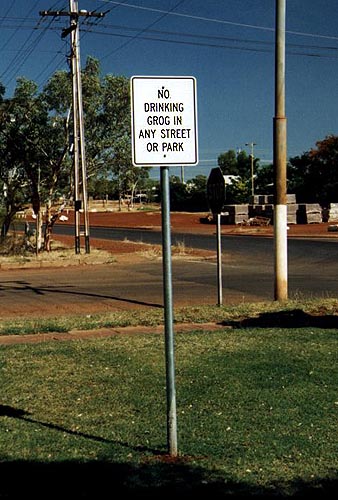
A classic sign
We relaxed in the hot sun by a very cold pool at the caravan park during the afternoon, before I cooked a barbecue dinner of steak satays, with onions, capsicum, potato salad and a bottle of red wine. Life was not always tough on the road, and we always took advantage of civilisation, especially when it was sandwiched between extended periods of roadside camping. The next town along the highway was Fitzroy Crossing, and it was two hundred and eighty seven kilometres away - over thirty kilometres longer than Glendambo to Coober Pedy which had been the previous longest strip of empty road we had encountered. Riding two hundred and eighty seven kilometres in two days was not a realistic prospect, given that each day would have to be longer than any other day we had ever done. With three days of riding we would only have to average a little under one hundred kilometres per day, a very do-able task.
The Swiss cyclists and many other travellers had recommended a free camping site by the Mary River known as Mary Pool, just over a hundred kilometres down the highway. A young couple from Karratha who were camped near us at Hall's Creek agreed to drop eight litres of water for us by the side of the road at the turn-off, and another eight litres at the FC 100 sign, a hundred kilometres out of Fitzroy Crossing. With all of our water supplies taken care of, we were ready to ride.
We rose before dawn and were well on our way by 6:30am, pushed along by a twenty kilometres per hour tail wind. The country was flat and dry with occasional distant hills. Around morning tea time with fifty nine kilometres behind us we were surprised to find collections of large boulders strewn across the terrain like the Devil's Marbles. Although not quite as impressive or extensive as their famous counterparts, the formations invited exploration and photographs. Karen and I spent a forty minute break amongst the rocks before riding on.
We stopped every time we saw birds we did not recognise, our binoculars always at the ready in our handlebar bags. The dry, semi-desert country yielded two new birds for our list - Ground Cuckoo Shrikes and Painted Firetails!
The tailwind made for great cycling and the kilometres flew by, giving us a string of performance records. We had not taken much notice of our progress in the first part of the day, but after three hours we had covered over seventy two kilometres. Almost twenty six kilometres in the fourth hour took us to just over ninety eight kilometres, with the one hundred kilometres mark reached five minutes later. Ten kilometres later we arrived at the Mary Pool turn-off. Despite the long morning tea break and the regular stops for stretching and bird watching, the early start and magic tailwind had gotten us to our overnight camp well before midday.
We picked up the eight litres of water which had been left at the turn-off then rode down a short dirt road and over a causeway to a large camping area. Mary Pool was aptly named, because the river was one large pool on the upstream side of the causeway, and a series of pools below. Some 4WD people from Coffs Harbour took our photo and said it would be mounted on the wall of their local bike shop when they returned home. They had just completed the Tanami Track in two days and had only dropped into Mary Pool for a quick lunch stop. A lot of kilometres were passing under their wheels, but how many were remaining in their memory? Karen and I again gave thanks that we were under no time constraints.
Because of the wonderful tailwind and the earliness of the hour, I tried to talk Karen into riding on, visions of records and the possibility of a two hundred kilometre day filling my tiny mind. The voice of sanity prevailed however, with Karen putting an immediate kybosh on continuing. Mary Pool had been recommended, and Mary Pool was where we would be staying the night. End of discussion.
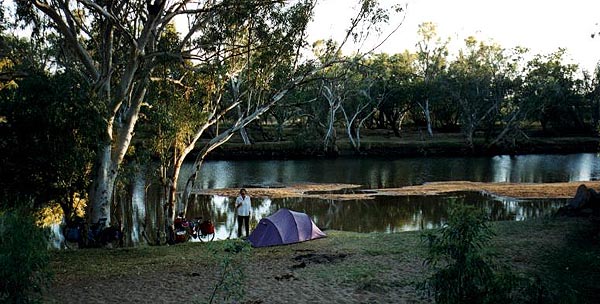
Our Mary Pool campsite
We set up our camp next to a suspicious rope tied to a tree stump down by the river, away from a scattering of caravans higher up. A light tug on the rope revealed a baited yabby trap, which was gently eased back into the water. It belong to Keith and Anne from Wollongong. We spoke at length to Keith when he came down to check the trap later in the day. He was typical of many of the fishermen travellers we met who tour around Australia, try every fishing spot and only move on if their catches are poor. Keith was full of information about the variety of yabbies in Western Australia and their relative merits and sizes.
The afternoon was devoted to relaxation. We walked out to the highway and down to the bridge over the Mary River on a bird walk that revealed nothing new. On the way back we spoke to a lady who was taking her little dog for a walk along the water's edge. She pointed out a small, freshwater crocodile in the middle of the pool which seemed to be keeping its eye on her dog, possibly with dinner in mind. By nightfall a horde of caravans had arrived at the camping area, its fame obviously widespread.
After a surprisingly quiet night, given the large number of travellers camped nearby, Karen and I rose at 5am intent on another early start. While we ate our breakfast Keith came down to check his trap, finding five fat cherubim, a large native yabby. He insisted we take them, so our early start was delayed as Keith slowly cooked the yabbies in a large pot over a small, open fire. When they were done and safely tucked away in a plastic bag, the cherubim looked more like big king prawns rather than the large clawed east coast yabbies Karen and I had hunted as children.
We eventually began riding a little after seven o'clock. The wind was not as strong as the previous day, but we still ripped along. I paid more attention to our performance over the first couple of hours as we breezed through fifty kilometres in an hour and fifty six minutes. A Few minutes later, at the two hour mark, our computers showed fifty one point six five kilometres. Both times and distances were new records for us.
Morning tea was a bizarre affair. We sat in scrubby shade by the side of a highway surrounded by a virtual desert, a hundred and fifty kilometres from the nearest town and fifty kilometres from the nearest water, quietly sipping our coffee and tea while dining on freshwater crayfish.
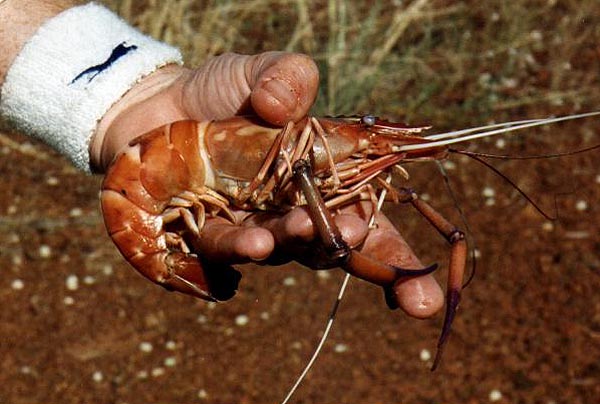
A Cherubim
We took things pretty easy after morning tea, but still managed a three hour record of seventy six point six kilometres. Not long afterwards we arrived at the Ngumpan Cliffs where a rest area and scenic lookout borders the highway as it swings down off the plateau through spinifex covered red soil and occasional small, white gum trees. We picked up our second lot of water dropped by Wendy and Jake from Karratha at the FC 100 sign, and rode out to the lookout for lunch. We had originally designated this rest area as the spot for our overnight camp, but it was too exposed, both to the elements and observation from the road.
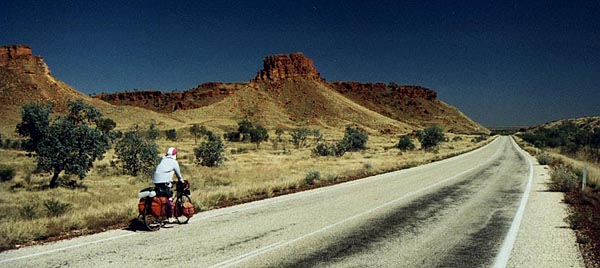
Riding past the Ngumpan Cliffs
The rugged beauty of the cliffline was a pleasant change from the flat countryside of the previous days, but we were soon out onto the flat plain beyond. Two frustrating hours followed as we searched in vain for a suitable campsite. The terrain was either too open for safe camping, or fenced off. We rode on and on, each of our bikes four kilograms heavier due to the extra water we had picked up. Around every corner we expected to find a decent camping site, but each new stretch of road brought only disappointment.
Our pace slowed as the afternoon dragged on. Even so, we still managed a five hour record of one hundred and nineteen kilometres. Twelve kilometres later, after an extra fifty kilometres of riding for which we had not been mentally prepared, we gave up hope of finding a good campsite, and settled for a bad one instead. An overgrown track led to a gate in the fence line, partially obscured by young eucalypts about six feet high. The track ended behind the gate, the paddock filled with thigh-high tussock grass and clumps of small gums, as if it had been ploughed under and then allowed to regenerate with native grasses and trees. There was no bare earth anywhere in the paddock. Karen and I pushed our bikes along the fence until we were out of sight of the road behind the low gums. Then we set about clearing a patch of ground for our tent, pulling out tussock after tussock until an area about three metres by two metres was laid waste.
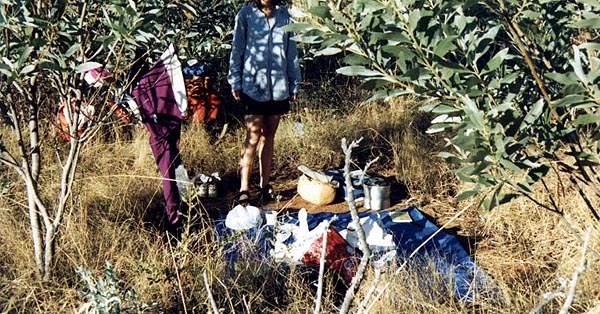
Our bush campsite
Many people we spoke too expressed the common belief that we could simply pull off the road and camp wherever we wanted, but experienced campers know that suitable sites are often difficult to find. They must be flat, cleared, and out of sight but still accessible. Most of Australia's highways are fenced. Unfenced highways always pass through open country. And despite being the flattest country on Earth, Australia's terrain is often undulating, if not downright hilly. Anyone who has ever set up a tent on the side of a hill knows the discomfort it can cause. When pushing heavy bikes over long distances in hot conditions, a sleepless night is the last thing we needed, hence our fussiness when selecting suitable camping sites.
Because of the extra distance we had ridden in search of a decent place to put up our tent, the next day to Fitzroy Crossing was a short one. The fifty seven kilometres was covered in less than three hours. We passed an upmarket resort and caravan park just before crossing over the Fitzroy River into town, but gave it a miss because it looked expensive. After seeing the state of the town and its alternate accommodation however, Karen and I were quite happy to seek the sanctuary of the resort, no matter what the cost. The price of a campsite was expensive, the highest we had paid since Uluru, but the security provided by the resort, the river and the mass of caravans and fellow travellers was too attractive to ignore.
The main attraction at Fitzroy Crossing is well out of town, at Geikie Gorge, where the Fitzroy River passes between low vertical cliffs of white, orange and black. During the afternoon Karen walked around the campground asking people if they intended doing the tour on the gorge tomorrow. When she found a likely couple, Karen then asked for a lift out and back, explaining that we were on bicycles. She returned to our tent with the news that Des and Leslie from Glen Waverley had offered us a lift for the following morning. With three days in the wilderness behind us, Karen and I were quite content to veg away the rest of the afternoon with reading and crosswords. In the evening we bought some soft drink and sat on the Lodge verandah under a light to continue our activities.
Des and Leslie were ready to go by 7:15am. It was luxury to sit in the back of their Jeep Cherokee and be chauffeur driven to the tour. Geikie Gorge is not the most spectacular gorge we have ever seen. Its walls are only about thirty metres high, and the width of the Fitzroy River in the Gorge makes the walls seem even smaller. However, what they lack in height they make up with colour and shape. The limestone of the lower parts of the walls, scoured white by the annual action of floodwaters from the Wet, has been eroded into a fascinating variety of weird and wonderful shapes. After the cruise was over Karen and I rated it as good - as opposed to great - with plenty of freshwater crocs and some nice rock formations to keep patrons interested. Strangely though, when we arrived back in Sydney and viewed the photographs we had taken, the scenery looked really excellent and much better than we remembered.
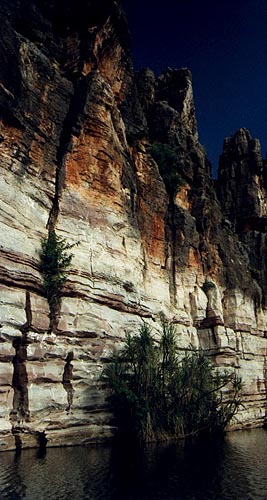
Geikie Gorge
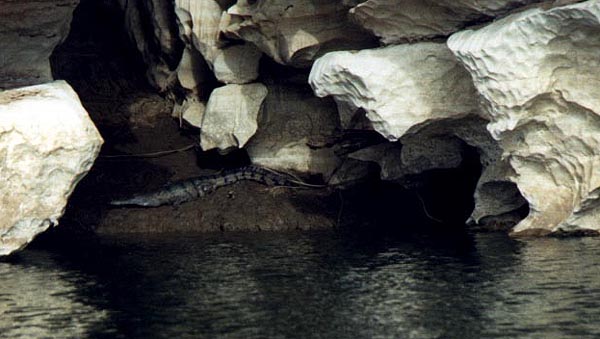
Croc in Geikie Gorge
Prior to lunch, and back in Fitzroy Crossing, we rode a little way out of the west end of town to look at the kilometre signposts. Derby was our next destination, but it is forty odd kilometres off the Great Northern Highway, so we were unsure whether the markers would measure the distance to Derby, or the intersection, or the Willare Bridge roadhouse near the intersection, or even Broome, another one hundred and eighty kilometres further on. We needed to know so we could advise people where to drop the water. It would be no good asking someone to drop the water at the "D 130" signpost, only to discover later that all the signposts are actually measuring the distance to Broome. The first signpost, a couple of kilometres down the road, read "D 250". During the afternoon we ran into a couple we had met at Mary Pool, and they agreed to drop eight litres of water at the "D 130" signpost.
There was no wind at 6:15am as we rode out of Fitzroy Crossing, but an hour later we hit a north-westerly breeze which made life difficult. We had a forty five minute morning tea by the side of the road at fifty two kilometres, with the beautiful sound of grey shrike-thrushes surrounding us. At eighty nine kilometres we came to Ellendale, the first rest area since Fitzroy Crossing and the best we had seen in Western Australia. It had a toilet, bins, shaded tables and seats and fireplaces, but of course, no water. We had arranged with Karen's brother Peter for a water drop at Ellendale, but after Karen found and retrieved the three litres he had left for us, we discovered the water was now home to a thriving culture of green algae. It had been almost a month since Peter and Mihkala had passed this way. We would not make the same mistake in the future, but luckily we had not been relying on this drop anyway.
We lunched at the Ellendale rest area for almost an hour and a half before returning to the battle with the headwind. With the kilometre posts to Derby rolling by, an ugly black storm cloud to the west held our attention for the next two hours. It seemed to follow us for a while before a turn in the road caused our paths to diverge.
The constant headwind was really getting us down. If we had not needed the eight litres of water at the one hundred and thirty kilometre sign, Karen and I would not have continued riding. Every new kilometre post was gratefully welcomed, the numbers slowly counting down towards one hundred and thirty. Finally we were inside the last kilometre. We rounded a bend in the road expecting to see the "D 130" sign, but were confronted instead by a totally unexpected scene. The side of the highway was a hive of furious activity, with road workers and trucks everywhere and a grader clearing the verges of the road.
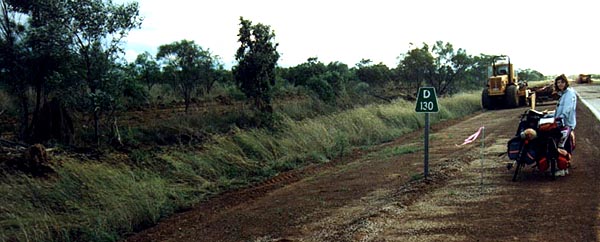
The D 130 sign
I looked towards the sign and saw from the scrapes on the road shoulder that the grader had begun its work about three metres on our side of the sign. Oh no, I thought, the grader has destroyed our water supplies! It was with some relief that I noticed the road gang foreman walk across the road towards us, probably to tell us where the water was located. Karen and I rolled to a stop near the sign as the guy approached.
"Are you looking for your water?" the foreman asked.
"We sure are," we both replied, happily.
"The people put it over there behind the termite mound," he said.
"What termite mound?" we asked, looking in the direction he was indicating and seeing only cleared scrub.
"Shit," he said. "I'm sure it was there just a little while ago."
He walked over the freshly dug earth and picked at something poking out of the ground. A mangled mess of muddy plastic appeared in his hand - the solitary remains of the four bottles of water.
"That was the only water we had," Karen said accusingly. "We won't be able to get any more until Derby. Have you got any water for us, to replace what your grader driver destroyed?"
"I'll see if I can get you some," the guy said, catching Karen's tone.
Karen and I propped our bikes together and I took out two empty wine cask bladders. We walked over to the back of a ute where the foreman had a polystyrene water-cooler sitting on the tailgate. We filled up one bladder before the cooler ran out of water. Karen prompted the guy to get some more, and pretty soon we had eight litres of icy cold water. We thanked the road gang foreman, loaded the water into our panniers and carried on up the highway, looking for a camping spot. We felt both unlucky and lucky at the same time. Unlucky because our water had been destroyed. Lucky because we had arrived in time to catch the road gang. We had arrived at the road-works shortly before knock-off time. If we had arrived a few minutes later, the site would have been deserted and Karen and I would have been forced to use water from roadside puddles, the remnants of the storm that just missed us earlier in the day.
We rode a further five kilometres before finding a good camping spot for the night. Our total distance for the day was one hundred and thirty six kilometres, our second longest day ever! The headwind had kept our average speed well down too, keeping us in the saddle for a bum numbing record of seven hours and nineteen minutes.
Our campsite was located in the middle of a track through a swampy area of paperbarks. The track had been used by Telstra when running a land line parallel to the highway. Karen and I barely had time to cook dinner and set up the tent before night fell, bringing with it a sudden onslaught of mozzies which drove us inside early.
Sometime during the night I became aware of the sound of heavy rain on the roof of the tent. I pressed the light on my watch, saw that midnight was still a half hour away and went back to sleep. Rain was still pelting down when the cold light of dawn arrived six hours later. The only other sound Karen and I could hear was the high pitched whining of hordes of hungry mozzies massed just outside the screens of our tent. It was not an auspicious start to the day.
Because it happens to us so rarely, Karen and I have very little experience of packing up the tent in the rain. With a long day ahead, however, we could not afford the luxury of lying around waiting for the rain to stop. During a slight lull in the deluge, Karen and I bolted out of the tent to fetch our rain jackets, then spent an hour and a half packing up the tent and standing around like drowned rats eating breakfast. The small patch of marshy water we had camped fifty metres away from the night before was now a large lake within metres of our tent. We gave thanks that the water level had not reached us during the night and forced a nocturnal relocation.
The rain eased shortly after we began riding and tapered off completely by the time we had covered fifteen kilometres, significantly improving our spirits. A bit later we were even able to chuckle as a sign announced that we were passing over the Erskine Range - a climb of fifty metres, tops! At forty two kilometres the road turned more northerly and directly into the breeze again. We began a roller coaster ride over vegetated sand dunes which ran from east to west. At fifty four kilometres we took a long break for morning tea, attempting to dry our tent, maps and groundsheet despite the constant threat of further rain. There were many storms in the area, but the rain gods were smiling upon us, having already had their fun with us at dawn.
When the road swung back to the west the wind followed suit. It was in our face for the rest of the day, giving us the paradoxical feeling that the road was uphill all the way down to the coast. At eighty five kilometres we reached the Derby turn-off and swung north with only forty two kilometres left to ride.
For the previous week we had been expecting to run into Cliff Young, the famous Australian long distance runner who had won the inaugural Sydney to Melbourne race at the age of sixty two. We had heard that he was on a charity run around Australia and was approaching the Kimberley. Karen and I had discussed what we would do when we saw him. We had heard that he would not slow down for photographs while he was running, so we planned to stop, lean our bikes together, grab our cameras, and take turns running along beside him while the other snapped a picture. We would later learn that we had missed seeing Cliff Young by only fifteen minutes. A traveller following along behind Karen and I told us she had passed Cliff Young and his entourage just before the intersection, and then when she had turned the corner and headed north she had passed us only a kilometre or two up the road. Unlike us, Cliffy was not going into Derby.
By the time we pulled off into a dirt road for lunch at the one hundred kilometre mark, the threat of rain was gone and the day had warmed up considerably. The final stretch into town was tough, with the road undulating over a long series of crests and floodways. The headwind made the job even more difficult. Karen and I had been rationing our water since morning tea time, and it finally ran out when we stopped for a photo at the western end of the Gibb River Road, six kilometres out of Derby. Although it took us less than half an hour to ride this last section, the earlier rationing had taken its toll and both of us were very thirsty by the time we reached town.
We craved soft drink and quickly looked for a Charlie Carters supermarket. We were amazed to find a Woolworths, complete with attached bottle shop, and we bought both soft and hard drink at good prices. At the caravan park our neighbours offered us a cuppa which we promptly accepted, desperate for liquids. Another caravan park resident walked by and nodded to us, puzzling us with a strange remark when he said "So you decided to stay in Derby, eh?" We later found out that a very similar looking couple to Karen and I, also cycling around Australia, had camped on our site the previous night and ridden out that morning. In the weeks ahead we would hear many more reports about this couple as we followed them down the coast.
Tracey, the caravan park manageress loaned us a couple of excellent garden chairs for the duration of our stay. After much needed showers and a few more drinks we phoned home to let the olds know we had arrived safely in Derby. Kevin told us that Peter and Mihkala were working on a property just outside of town. He gave us the phone number, and Karen rang up, leaving a message with a boy who answered the phone.
We had been on the road for thirty two days since Darwin and had ridden almost two thousand kilometres at an average of over ninety kilometres per day. Even with the rest days thrown in, our daily average was still over sixty, more than twice our usual rate.
It was time to take a decent break.
|







